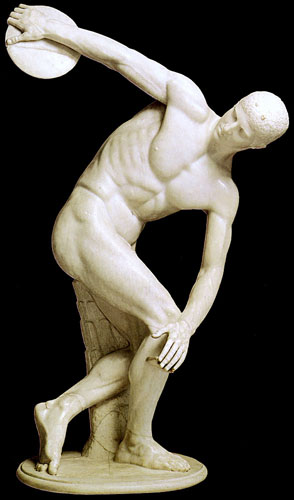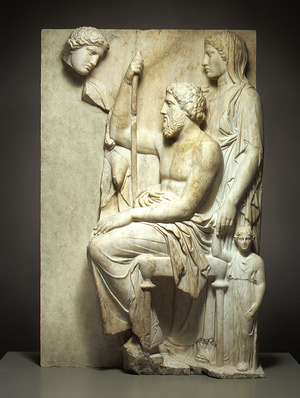Ancient Sculpture
The origins of Greek sculpture have been traditionally ascribed to the wooden cult statues described by Pausanias as xoana. No such statue survives and the descriptions of them are frustratingly vague despite the fact that some were objects of veneration for hundreds of years. The first piece of Greek statuary come down to us is probably the Lefkandi Centaur (Eretria Mus.) found on Euboia. This terracotta statue of circa 900 BC was constructed in parts before being dismembered and buried in two separate graves, it bears an intentional mark on its knee perhaps indicating it represents Cheiron and the wound from Herakles’s arrow, if so it would be the first depiction of myth in Greek art.
Of the forms of art from the geometrical period (ca. 900 to 700 BC) we have terracotta figurines, bronzes and ivories. The bronzes are chiefly tripod cauldrons and freestanding figures or groups. Such bronzes were made using the lost-wax technique probably introduced from Syria and are almost entirely votive offerings left at the Panhellenic sanctuaries of Olympia, Delos and Delphi. These were manufactured elsewhere and a number of local styles may be identified by finds from Athens, Argos and Sparta. Typical works of the era include the Karditsa warrior (Athens Br. 12831) and the many examples of the equestrian statuette (for example, NY Met. 21.88.24 online). The repertory of this bronze work is not confined to standing men and horses however, as with the vase painting of the time we also find stags, birds, beetles, hares, griffins and lions. There are no inscriptions on early to middle geometric sculpture until the appearance of the Mantiklos "Apollo" (Boston 03.997) of the early 7th century found in Thebes. This is a standing figure of a man with an almost daedalic form with the legend "Mantiklos offers me as a tithe to Apollo of the silver bow; do you, Phoibos, give some pleasing favour in return" across his thighs in hexameter verse. Apart from the novelty of recording its own purpose this sculpture it adapts the formulae of oriental bronzes as seen in the shorter more triangular face and slightly advancing left leg. This is sometimes seen as anticipating the greater expressive freedom of the 7th century and as such the Mantiklos figure is referred to in some quarters as proto-daedalic.
The gallery of ancient sculpture need to say "thank you" to French Louvre(French: Musée du Louvre). Their generous lending of "Venus de Milo" and "Discobolus" make our exhibition more splendid.
|
 Venus de Milo
Venus de Milo
The Aphrodite of Milos, better known as the Venus de Milo, is an ancient Greek statue and one of the most famous works of ancient Greek sculpture. It is believed to depict Aphrodite (called Venus by the Romans), the Greek goddess of love and beauty. It is a marble sculpture, slightly larger than life size at 203 cm (6.7 ft) high. Its arms and original plinth have been lost.
The statue was discovered by a peasant named Yorgos Kentrotas in 1820 inside a buried niche within the ancient city ruins of Milos on the Aegean island of Milos, also called Melos or Milo. It was found in two main pieces (the upper torso and the lower draped legs) along with several herms (pillars topped with heads), fragments of the upper left arm and left hand holding an apple, and an inscribed plinth. Olivier Voutier, a French naval officer, was exploring the island. With the help of the young farmer, Voutier began to dig around what were clearly ancient ruins. Within a few hours Voutier had uncovered a piece of art that would become renowned throughout the world. About 10 days later, another French naval officer, Jules Dumont d'Urville, recognized its significance and arranged for a purchase by the French ambassador to Turkey, Charles-François de Riffardeau, marquis, later duc de Rivière.
Twelve days out of Touloun the ship was anchored off the island of Melos. Ashore, d'Urville and [fellow officer] Matterer met a Greek peasant, who a few days earlier while ploughing had uncovered blocks of marble and a statue in two pieces, which he offered cheaply to the two young men. It was of a naked woman with an apple in her raised left hand, the right hand holding a draped sash falling from hips to feet, both hands damaged and separated from the body. Even with a broken nose, the face was beautiful. D'Urville the classicist recognized the Venus of the Judgement of Paris. It was, of course, the Venus de Milo. He was eager to acquire it, but his practical captain, apparently uninterested in antiquities, said there was nowhere to store it on the ship, so the transaction lapsed. The tenacious d'Urville on arrival at Constantinople showed the sketches he had made to the French ambassador, the Marquis de Riviére, who sent his secretary in a French Navy vessel to buy it for France. Before he could take delivery, French sailors had to fight Greek brigands for possession. In the mêlée the statue was roughly dragged across rocks to the ship, breaking off both arms, and the sailors refused to go back to search for them.
|
 Discobolus
Discobolus
The Discobolus of Myron ("discus thrower" Greek Äéóêïâüëïò, "Diskobolos") is a famous Roman marble copy of a lost Greek bronze original, completed during the zenith of the classical period between 460-450 BC. A discus thrower is depicted about to release his throw. The moment captured in the statue is an example of rhythmos, harmony and balance. Myron is often credited as being the first sculpture to master this style. Naturally, as always in Greek athletics, the Discobolus is completely nude. His pose is said to be unnatural to a human, and today considered a rather inefficient way to throw the discus. Also there is very little emotion shown in the discus thrower's face. The other trademark of Myron depicted in this sculpture is how well the body is proportioned, the symmetria. The Diskobolus Palombara stands at 1.55 meters tall (5 feet, 1 inch).
An explanation for his inefficient discus throwing could be that the ancient Olympic sportsmen had a set rotation of three quarters before the discus was thrown. This rotation could well have been a deliberate handicap to make the sport more difficult.
Following its discovery in 1781, at a Roman property of the Massimo family, the Villa Palombara on the Esquiline Hill, it was initially restored by Giuseppe Angelini, and the Massimi installed it initially in their Palazzo Massimo alle Colonne then at Palazzo Lancelotti. The Italian archeologist Carlo Fea identified the sculpture as a copy from the original of Myron. It was instantly famous, though the Massimo jealously guarded access to it (Haskell and Penny 1981:200).
Prior to this statue's discovery the term Discobolus had been applied in the seventeenth and eighteenth centuries to a standing figure holding a discus, a Discophoros, which Ennio Quirino Visconti identified as the Discobolus of Naukydes of Argos, mentioned by Pliny (Haskell and Penny 1981:200).
|
 Grave stele with a family group
Grave stele with a family group
In the center of this grave stele, a bearded man with a mantle draped over his legs and lower torso sits in rigid profile on a diphos (backless chair); he holds a staff in his raised right hand. Behind him stands a veiled woman who clasps the hand of a little girl. The child, draped in a chiton belted high above her waist, stares out at the viewer. A fourth, now fragmentary, female figure stands to the left of the group. With her left hand, she gently touches the arm of the seated man. Both he and the veiled woman behind him stare straight ahead as if the young woman who gazes down at them were invisible. The impression is that this young woman belongs to a world separate from that of the other three figures.
The name of the deceased would have been inscribed on the framing niche that originally surrounded this relief, but is now missing. Without this inscription it is unclear if the man and his family members mourn a dead daughter that faces them, or if the veiled woman who stands behind the seated man is actually mourning her dead father.
Asian Art
European Art
Middle East Art

Back to the Main Page
|
 Venus de Milo
Venus de Milo
 Discobolus
Discobolus
 Grave stele with a family group
Grave stele with a family group